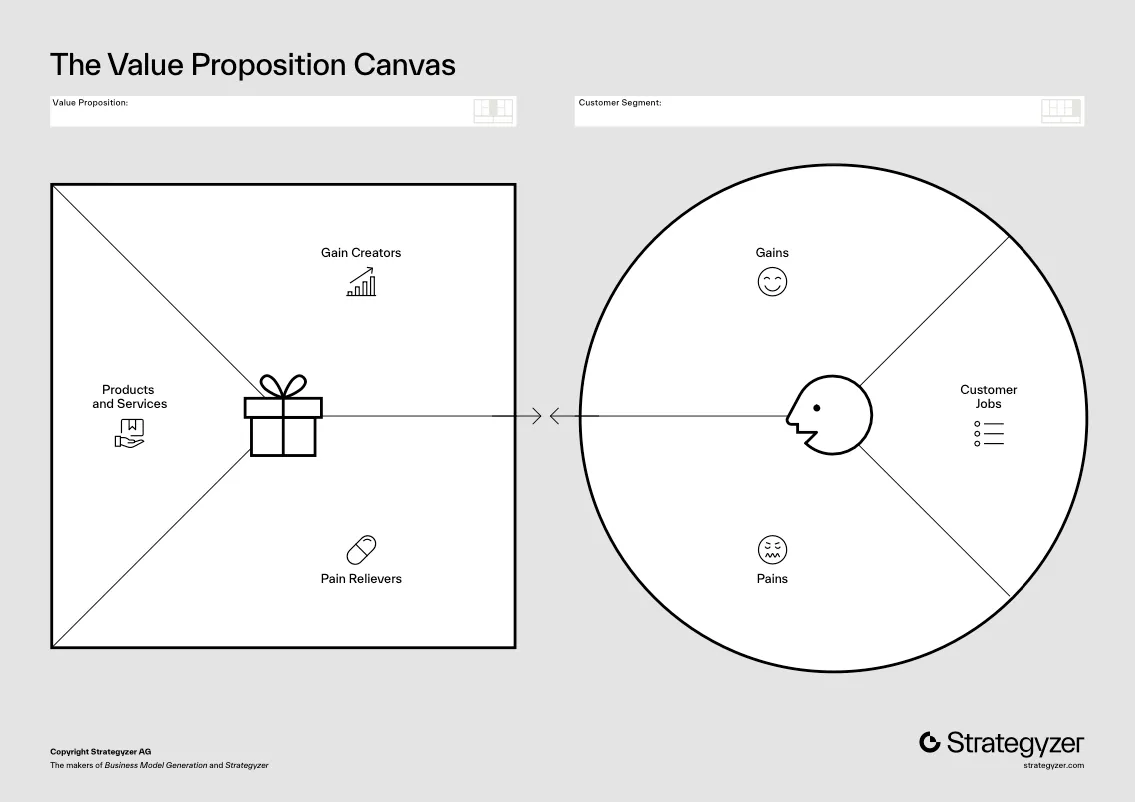A strong value proposition is the cornerstone of any successful business strategy, but crafting one that truly resonates can be challenging. Imagine trying to communicate what sets your business apart in just a few sentences—this is where many companies falter. But what if you could develop a value proposition so compelling that it not only captures attention but also drives market dominance?
In this post, we’ll explore the key elements that make up an effective value proposition and how you can apply proven frameworks to ensure yours stands out.
- A compelling value proposition is essential for differentiating your business and capturing market attention.
- Key elements of a strong value proposition include clarity, relevance, and uniqueness, which must resonate with your target audience.
- Proven frameworks like the Value Proposition Canvas can help in systematically developing an effective value proposition.
- Avoid common mistakes such as vague or overly complex propositions by focusing on clear, concise messaging.
- Testing and refining your value proposition through customer feedback and market research is crucial for maintaining relevance.
- Implementing a value proposition across all marketing and sales channels ensures consistency and enhances its impact.
What elements should I consider when crafting a distinctive value proposition?
The value proposition canvas is a valuable tool for aligning a product or service more closely with the needs of its target customers. Developed by Dr. Alexander Osterwalder, this framework helps businesses build robust value proposition strategies. It is particularly useful for refining existing offerings or developing new ones.
Customer Profile Map
Creating a detailed customer profile is essential. This profile should reflect the customer’s jobs, pains, and gains:
- Customer Jobs: These include the social, functional, and emotional tasks that customers aim to accomplish, the wishes they seek to fulfil, and the problems they need to solve.
- Gains: These are the benefits that customers desire, the outcomes that would delight them if their tasks are accomplished well.
- Pains: These refer to the negative experiences, risks, and emotions that customers encounter when their tasks are not completed.
Value Proposition Map
The value proposition map comprises:
- Gain Creators: How the product generates positive gains and benefits for the customer.
- Pain Relievers: How the product alleviates customer pains.
- Products and Services: The offerings that provide the necessary pain relief and gains for customers.

What Matters Most?
Crafting a value proposition that resonates often involves articulating its significance beyond mere offerings. Clients typically discover that emotional connections can enhance engagement and loyalty. Regular reassessment is vital, as markets and customer needs evolve constantly; neglecting this can leave businesses vulnerable to competitors. Aligning your value proposition with brand values is another strategic move that fosters loyalty, reinforcing the idea that what you stand for matters just as much as what you sell.Get In Touch
What are common pitfalls in developing a value proposition strategy?
Unrealistic Market View
During the initial stages of building your market and business strategy, competitor and market scoping should have highlighted how your product compares and can be positioned. If you considered your product innovative and incomparable to existing solutions and still find it struggling to break through, it’s crucial to reassess if you’re in the right market.
Products can be repositioned and remarketed. If something isn’t working, it’s essential to pivot and try a different approach. Your solution might be more suited to an entirely different industry. This adaptability is a key aspect of effective value proposition strategies.
Using Templates
There are numerous tools and guidance available for developing a value proposition framework. However, it’s important to use these as part of a customised process that fits your business needs. Templated examples can often be dry and lack creativity. Collaborating with a mentor, coach, or a marcomms agency can help tailor a framework that works for your specific situation.
Source: Invesp
Failing to Test the Sales Process
The urgency to sell quickly can be detrimental if you haven’t validated your value proposition strategy. Investing time and resources at the beginning to get your sales process right is crucial. Testing the sales process from the start helps lay a solid foundation.
Understanding what initially attracts people, how they build confidence to purchase, their purchase barriers, and their feedback on the sales cycle can provide valuable insights. This evidence supports refining your value proposition and developing a robust sales funnel.
Claiming More Value or a Better Price
A common pitfall is focusing solely on price, especially when offering more than a commodity. SprezzaBox exemplifies this mistake by basing customer attraction almost entirely on pricing, necessitating them to always be the cheapest. This approach commoditises the brand and aligns it with a customer base that may not share the same values or standards.
In B2B services, it’s risky to play the price game. The goal should be to sell unique services that cannot be easily replicated. Attracting clientele based on price alone can lead to misaligned values and constant effort to justify the value being delivered. Instead, focus on articulating the unique value your service offers as part of a comprehensive value proposition framework.
How can I apply the “Jobs-to-be-Done” theory to enhance my value proposition?
The “Jobs-to-be-Done” theory, introduced by Clayton Christensen in his 1999 bestseller The Innovator’s Solution, offers a profound understanding of the motivations behind why customers purchase a product or service. Closely related to the value proposition canvas, this theory delves deeper into the fundamental reasons for customer behaviour, focusing on the idea that consumers hire products or services to fulfil specific jobs.
Implementing the “Jobs-to-be-Done” theory allows brands to craft solutions that stand out in their industries, providing them with a competitive edge. Here’s how:
Consumer Purchase Motivation:
-
- Customers buy products and services to accomplish particular tasks or solve problems.
- By understanding these jobs, brands can move beyond just offering functional benefits and start addressing the emotional gains their products or services provide.
Building Brand Loyalty:
-
- When customers identify a brand as the best solution for their needs, they default to using it to get their job done. This fosters brand loyalty.
- Product development teams can then focus on metrics that matter most to customers, asking, “How well did we get the job done?”
Enhancing Marketing Innovation:
-
- A thorough understanding of the customer’s job-to-be-done makes marketing efforts more innovative and effective.
- When developing value propositions, it is crucial to consider these jobs to ensure the offered solutions align perfectly with customer needs.
Integrating Jobs-to-be-Done into Product Innovation Strategy
A robust product innovation strategy should function like a compass, steering the brand towards delivering maximum value to the customer. By using the jobs-to-be-done framework in conjunction with the value proposition canvas, brands can ensure they remain focused on the core functional jobs their customers need to accomplish.
Guiding Product Innovation:
-
- The framework helps in pinpointing the core jobs that are essential to customers, ensuring that the innovation efforts are directed towards the most impactful areas.
- This strategic focus aids in developing solutions that not only meet but exceed customer expectations.
Our Tactical Recommendations
Developing a clear product vision is critical; it directly ties your value proposition to customer pain points, ensuring relevance. We often find that focusing on niche markets yields a more profound resonance with our audience. Additionally, leveraging competitive insights to refine your offering can uncover opportunities that many overlook, enabling a more effective and targeted approach to value delivery.Get In Touch
Best Real World Examples of Value Propositions
Stripe: “Web and Mobile Payments, Built for Developers”
Stripe is a leading online payment tool that enables businesses to accept and manage payments effortlessly. Targeting business owners and developers, Stripe’s primary benefit lies in its promise of “simple and streamlined payments.” This value proposition strategy highlights the brand’s focus on ease of use and efficiency, making it an essential tool for its target market.
Uber: “Get There: Your Day Belongs to You”
Uber, the world’s premier ride-hailing app, directly addresses the travel challenges faced by its users. By focusing on the customer’s needs and incorporating the word “you,” Uber’s value proposition framework emphasises personal convenience and freedom, making travel hassle-free and empowering users to reclaim their day.
Target: “Expect More, Pay Less”
Target’s value proposition appeals to cost-conscious shoppers seeking quality products. By striking the perfect balance between affordability and quality, Target’s value proposition strategy effectively communicates how shoppers can obtain superior items without compromising on price, thereby attracting a broad customer base.
Skillshare: “Learn a New Skill Each Day”
Skillshare targets creative minds and entrepreneurs with its easily accessible and affordable online lessons. By offering quick, focused, and on-demand learning experiences through bite-sized lessons, Skillshare’s value proposition framework resonates strongly with its audience, providing an appealing solution for continuous learning and skill development.
Evernote: “Remember Everything”
Evernote serves students, busy individuals, and professionals by offering a comprehensive organisational tool. The app allows users to store notes, photos, audio clips, and other data in one place. Evernote’s value proposition strategy is clear: it helps users organise their thoughts and information seamlessly, ensuring they never lose track of important ideas or details.
Source: The Guardian
Spotify: “Music for Everyone”
Spotify’s value proposition embraces inclusivity, catering to all music lovers. By not singling out any particular segment, Spotify ensures its service is universally appealing. This strategy enhances its value proposition framework by making music accessible and enjoyable for everyone, irrespective of their musical preferences.
Thumbtack: “Consider It Done”
Thumbtack offers a simple yet effective solution for those needing professional services. Its concise value proposition, “Consider it Done,” clearly reflects the ease and reliability of hiring professionals through their platform. This straightforward approach ensures users understand the benefits immediately.
Bitly: “Shorten. Share. Measure”
Bitly’s value proposition is succinct and direct, focusing on the three critical aspects of link management: shortening, sharing, and measuring. By eliminating any unnecessary language, Bitly’s value proposition strategy effectively communicates its core functionalities, making it an indispensable tool for digital marketers.







